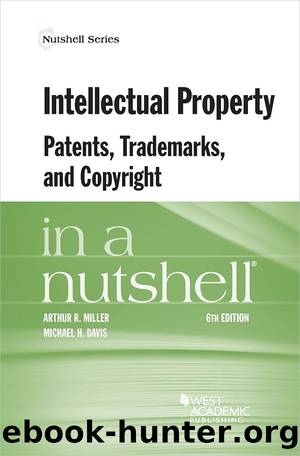Intellectual Property, Patents, Trademarks, and Copyright in a Nutshell by Arthur Miller & Michael Davis

Author:Arthur Miller & Michael Davis
Language: eng
Format: epub
ISBN: 9781634599023
Publisher: West Academic
Published: 2018-07-15T00:00:00+00:00
§ 14.5ABANDONMENT
Trademark rights can be acquired only through use rather than adoption or appropriation in gross. Trademark rights therefore are a function of commercial reality. Thus, just as absence of use is a bar to the acquisition of legal rights, failure to use a mark after the acquisition of legal protection may constitute a bar to continued protection. The latter context is called abandonment.
To constitute abandonment, an owner either must discontinue use of the mark with the intent not to resume use, or the owner must do something or fail to do something that causes the mark to lose its distinctiveness. The first might be termed actual abandonment, since it is a subjective inquiry relating to the actual intention of the owner. The second might be termed constructive or legal abandonment since it applies irrespective of the owner’s actual intent. To avoid a finding of actual or constructive abandonment, the Trademark Law Revision Act of 1988 (“TLRA”) requires actual commercial use, not token use. In other words, the statute demands “bona fide use of a mark in the ordinary course of trade.” 15 U.S.C.A. § 1127.
Section 1052(d) provides that a previously used mark can be appropriated if the earlier owner has abandoned the mark. Thus, abandonment may be a defense to the claim that registration either should not be granted or was granted improperly. Also, 242
abandonment is one of only nine legitimate defenses to a claim by a user whose rights have become incontestable.
In a registration proceeding, a claim by the applicant of a prior user’s abandonment may be challenged by that prior user insisting that it still has the right to the mark. Similarly, in an opposition proceeding, or in an interference declared by the PTO, an applicant may have to answer the claim by a prior user that the mark never had been abandoned. More frequently, the issue of abandonment arises in a cancellation proceeding in which the government or a rival party seeks to cancel the registration of a user who allegedly has failed to exercise the federal rights conferred by registration. It also may arise in a judicial proceeding, most often involving infringement, when a user defends its use of a mark by claiming that the plaintiff abandoned the mark.
Actual abandonment does not occur simply by nonuse. In addition there must be an actual intent to discontinue the use. If a person is forced to discontinue use merely because of economic pressures but has no intention to discontinue the use permanently, it is excusable nonuse and does not constitute abandonment. Miller Brewing Co. v. Oland’s Breweries [1971] Ltd., 548 F.2d 349 (CCPA 1976). If a person fails to use a mark for three years, it is presumptively abandoned. Upon proof of nonuse, the burden shifts to the registrant to show excusable nonuse. Nonuse is excusable when it constitutes what a reasonable business person having intent to 243
use the mark would do. Rivard v. Linville, 133 F.3d 1446 (Fed. Cir. 1998). Because of the two-part test, presumptive
Download
This site does not store any files on its server. We only index and link to content provided by other sites. Please contact the content providers to delete copyright contents if any and email us, we'll remove relevant links or contents immediately.
Bullshit Jobs by David Graeber(3190)
Radical Candor by Kim Scott(2225)
I Am Right, You Are Wrong by Edward De Bono(2109)
23:27 by H. L. Roberts(1894)
Nomadland by Jessica Bruder(1688)
Average Is Over by Tyler Cowen(1542)
High-Impact Interview Questions by Victoria A. Hoevemeyer(1403)
Out of Our Minds: Learning to Be Creative by Ken Robinson(1382)
The Conflict Resolution Phrase Book by Barbara Mitchell & Cornelia Gamlem(1348)
The Ideal Team Player by Patrick M. Lencioni(1317)
An Everyone Culture: Becoming a Deliberately Developmental Organization by Robert Kegan & Lisa Laskow Lahey(1295)
The Asshole Survival Guide by Robert I. Sutton(1285)
Automatic Society by Bernard Stiegler(1224)
Unleashed by Anne Morriss & Frances Frei(1222)
Who by Street Randy & Smart Geoff(1201)
42 Rules of Employee Engagement by Susan Stamm(1192)
Who Moved My Cheese?: An Amazing Way to Deal With Change in Your Work and in Your Life by Johnson Spencer(1180)
96 Great Interview Questions to Ask Before You Hire by Paul Falcone(1134)
The Power of Disability by Al Etmanski(1083)
